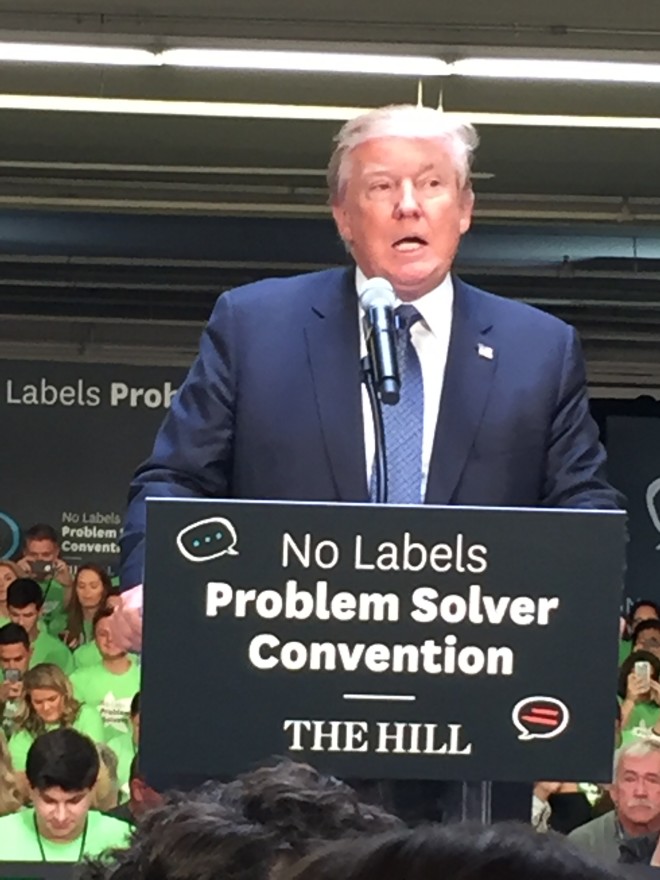As the 2016 campaign races on, Presidential candidates are determined to sell, how they will solve American household pain points. Donald Trump has certainly tapped into one of those, the outsourcing of manufacturing jobs to Asia, “We’re going to get things coming. We’re gonna get Apple to start building their damn computers and things in this country instead of in other countries.” It’s a loaded statement that requires considerable clarification. Trump on Apple.
While Apple does manufacture iPhones, iPads, and Macs in China, a practice that began in the late 1990’s, Apple research and design programming continues to grow at its headquarters in Cupertino, California. In October 2013, building on the original Apple Campus I, 6 buildings on 32 acres, on private U-shaped street “Infinite Loop”, the Cupertino City Council unanimously approved plans for Apple Campus II, at a projected $5 billion construction cost, with worldwide acclaimed architect Lord Norman Foster in charge of the design. Apple has had a presence in Cupertino since 1977, which is why they chose to expand there, rather than move to a cheaper distant location. Apple Campus II update.
In 2013, Apple employed 16,000 on Campus I, the second largest technology employer in Silicon Valley, and is projected to add 7,400 more jobs with the addition of the $5 billion Campus II in 2016, despite a $44 decline in stock price from $100 in September 2012 to $56 in April 2013. Today it closed at $109.81. In total, Apple is projected to employ 41,000 in Santa Clara County in 2016. Cupertino employees earned an average $125,000 salary in 2012, with most living in San Jose, the 7th most expensive city in America. In 2012, Apple generated $103 million in gross sales to the local economy, and $25 million in local property tax. Interesting Apple facts.
In 2015, Apple become the first Silicon Valley tech firm to top $200 billion in revenue, on net sales of $233.7 billion resulting in $53.4 billion net income, 23% net margin, and earnings per share of $9.28, a masterful performance compared to 2014, up 35% to net income of $39.5 billion, and up 43% to earnings per share of $6.49. Compared to 2011, net income has more than doubled, earnings per share is up 62%, and Apple has been able to maintain consistent net margin at 22- 24%. Apple 2015 Financials. I wonder if Donad Trump has stock in Apple.
Back to the issue at hand, manufacturing jobs in Asia. CEO Tim Cook has tried to bring manufacturing jobs back home, but a widening skills gap in the U.S. makes that very difficult. While our economy continues to improve, U.S. manufacturers face significant challenges as a sizeable gap exists between the need to grow their business, and the talent available. The challenge will only increase. As nearly 3.5 million manufacturing jobs will likely need to be filled in the next 10 years, 2.7 million on baby boomer retirement and 0.7 million on natural business growth, the skills gaps is projected to result in 2 million unfilled jobs. Other factors include movement of experienced workers, a negative image of the manufacturing industry among younger generations, lack of STEM skills among workers, and a gradual decline of technical education in public high schools. U.S. manufacturing has shifted to more streamlined and automated processes. While some roles will require less technical aptitude, these trends in innovation actually demand more skilled workers. Manufacturing Skills Gap.
Of course the dramatic growth in trade between China and the US, since the 2001 entry of China to the World Trade Organization, has had a profound effect on the U.S. worker economy. The initial vision of China’s WTO entry predicted U.S. job creation and trade deficit improvement with China; and was rooted in history growing out of the 1944 Bretton Woods agreements, negotiated by the Allied nations, that created the IMF and World Bank. The 1947 General Agreement on Tariffs and Trade (GATT) followed, establishing the international trading system that refined the rules to lower tariffs and non-tariff barriers. This finally led to the creation of the World Trade Organization in 1994, whose mission was to settle disagreements arising from GATT treaty rules. The WTO was authorized to take action if decisions were ignored or rejected by member governments. It broadly expanded coverage on points never before included in trade agreements, including food safety, environmental laws, social service policies, intellectual property standards, and government procurement rules. Over time, this attracted countries who were never a part of GATT, to gain improved market access for their goods at lower tariff levels. China’s entry was supposed to bring the country into compliance. The U.S. also negotiated measures to limit surging imports from China on domestic U.S. producers. In the end though, China’s currency manipulation, wage and labor rights suppression, and foreign country direct investment in Chinese enterprise, has created a huge trade deficit problem for the U.S., which in turn has disrupted 2.1 million U.S. manufacturing jobs between 2001 and 2011, with 1 million in the computer and electronic products industry.
The major cause of the growing U.S. trade deficit with China is currency manipulation. Unlike most major currencies, the Chinese yuan does not float freely against the dollar. As Chinese productivity has soared, its currency should have too, to maintain balanced trade. It has instead remained artificially low on aggressive acquisition of foreign exchange reserves to increasingly depress the value of the yuan. In 2012, noted economist H.W. Brock estimated the Chinese currency to be “arguably one-sixth of what it should be”. 2012 research by Economist Joseph E. Gagnon, estimated that massive currency manipulation, especially in countries in Asia, had raised “the current account of the developing economies by roughly $700 billion per year, relative to what it would have been.” He also notes this “amount is roughly equivalent to the large output gaps in the United States and Euro area. In other words, millions more Americans and Europeans would be employed if other countries did not manipulate their currencies…” For more of his thoughts on a broader view of global currency manipulation, please refer here.
The US trade deficit with China was ($365.7) billion in 2015, more than tripling since 2000 at ($83.8) billion, increasing nearly 11% annually on average over this 15 year period. The annual trade deficit growth has slowed since the global financial crisis in 2008, averaging 16% pre crisis, to 5% in the period since. To access the source data I used to create this graph, please refer here.
As an analyst with 25 years experience helping global business heads drive P&L growth, I must confess it’s a sobering picture. I suppose you can say Donald Trump is technically correct when he says we negotiated bad trade deals with China. The pain point to solve though, will require diligent and carefully crafted strategy among WTO members, to punish currency manipulators in a meaningful way that packs a punch. The U.S. and Euro area countries, as main targets of currency manipulation, will have to play tough. The WTO has the ability to impose tariffs on imports from currency manipulators, with such practices consistent with international law. This ideally could lead to full revaluation of the yuan, which a 2011 report showed would improve the current U.S. account deficit by $190.5 billion, add 2 million jobs, and reduce the federal deficit by up to $857 billion over 10 years.
Clearly this is a complex global issue. The purpose here is to highlight and frame the key issues, with a particular focus on currency manipulation only. For a more thorough read on this complex broad topic, please refer to this publication produced by the labor movement affiliated Economic Policy Institute, plus any other sources you deem appropriate to get an accurate and representative understanding.
To wrap up, as I become nostalgic thinking back to my undergraduate Economics classes in the early 80’s, my Rock&Roll tee shirts manufactured in the good old USA, that I still wear today; and to Steve Jobs who began his mission with Apple in 1977 to transform our world with passionate innovation, I leave you with this classic performance, “.. and it makes me wonder. She does..” Enjoy!



